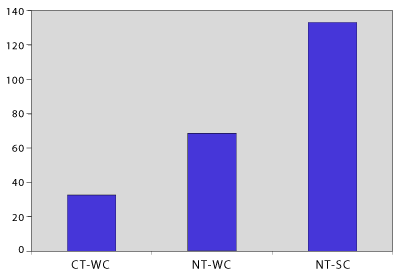Earthworms
What it is: Earthworms are native to non-glaciated areas of North America, but non-native species from Europe and Asia also exist here. Earthworms are classified into three groups based on their habitat. Litter-dwellers live in the litter, ingest plant residues, and may be absent in plowed, litter-free soil. Mineral soil-dwellers live in topsoil that is rich in organic matter. They burrow narrow channels and feed on a mixture of soil and plant residues. Deep soil-burrowers (night crawlers) dig long, large burrows into deep soil layers. They carry with them plant residues for consumption. Earthworm cast is digested material that is excreted back into the soil. Cast is enriched with nutrients (N, P, K, and Ca) and microorganisms during its passage through the worm’s digestive system. Fresh cast is a site of intense microbial activity and nutrient cycling. Earthworms contribute nutrients to the soil and improve porosity, tilth, and root development. They are measured in number/m2.
Why it is important: Despite some reservations, there is evidence that earthworms contribute to crop production. Earthworms play a key role in modifying the physical structure of soils by producing new aggregates and pores, which improves soil tilth, aeration, infiltration, and drainage. Earthworms produce binding agents responsible for the formation of water-stable macro-aggregates. They improve soil porosity by burrowing and mixing soil. As they feed, earthworms participate in plant residue decomposition, nutrient cycling, and redistribution of nutrients in the soil profile. Their casts, as well as dead or decaying earthworms, are a source of nutrients. These beneficial effects stimulate root growth and proliferation deep into the soil to satisfy nutrient and water requirements. Roots often follow earthworm burrows and uptake available nutrients associated with casts. Lumbricus terrestris, or the night crawler, and other nonnative earthworms have displaced many native species across the United States. In Northern forests, their populations can reach such high levels that no litter can be maintained on the forest floor.
Specific problems that might be caused by poor function: Low or absent earthworm populations are an indicator of little or no organic residues in the soil and/or high soil temperature and low soil moisture that are stressful not only to earthworms, but also for sustainable crop production. Earthworms stimulate organic matter decomposition. Lack of earthworms may reduce nutrient cycling and availability for plant uptake. Additionally,
natural drainage and aggregate stability can be reduced. Soil remediation to increase nutrient cycling, break up compacted layers to improve aeration and drainage, and stabilize soil to protect it from erosion may be needed. Some soils are naturally productive without earthworms because of their inherent properties.
What you can do: No-till increases plant residues and improves soil structure, providing improved habitat for earthworms. Studies conducted in the Midwest showed that in no-till systems, the combination of soil moisture, temperature, and quality of food supply are essential factors for earthworm population growth. Legumes, alone or in rotation, seem to be preferred by earthworms because of the quality of food they provide (figure 1). Deep soil-burrowers are lacking in plowed fields and changing to no-till may not help their quick establishment unless they are introduced first. Seeding earthworms is a potential technique to reintroduce them, but it is not practical on a large scale. Compared to other ecosystems, agricultural soils are generally dominated by species adapted to disturbance, low organic matter content, and a lack of surface litter, so the management practices listed below should increase earthworm populations. Sandy or wet heavy clay soils may not naturally harbor significant earthworm populations, but irrigation and drainage can help provide favorable conditions for earthworms to thrive. (In areas where restoration of native species is a goal, removal of exotic species is a must.) Carefully consider pesticide applications, as some, such as carbamate insecticides (table 1) and carbendazim and benomyl fungicides, have severe adverse effects on earthworms.
The following practices boost earthworm populations:
- Tillage Management (no-till, strip till, ridge till)
- Crop Rotation (with legumes) and Cover Crops
- Manure & Organic By-product Application
- Pasture & Hayland Management
- Soil Reaction (pH) Management
- Irrigation or Drainage
For more information go to Soil Management Practices.

Figure 1. Effect of tillage and crop on earthworm number/m2 CT=conventional till, NT= no-till; W=wheat, C=corn, S=soybean Adapted from Hubbard, et al. 1999.
| Table 1. Insecticides harmful to earthworms | |
| Common Name | Trade Name |
|---|---|
| Aldicarb | Temik |
| Carbaryl | Sevin |
| Carbofuran | Furadan |
| Clorpirifos | Dursban |
| Methomyl | Lannate |
Measuring earthworm abundance:
Earthworm populations are measured by counting the number of earthworms/m2 as described in the Soil Quality Test Kit Guide, Section I, Chapter 10, p 22-23. See Section II, Chapter 9, p 73 - 75 for interpretation of results.
Hubbard VC, et al. 1999. Earthworm response to rotation and tillage in Missouri claypan soil. Biol Fertil Soils 29:343-7.
